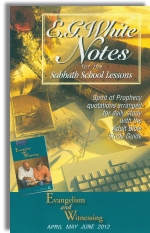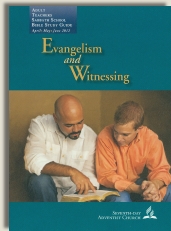|
||||||||||||||
Commentary on "Equipping for Evangelism and Witnessing"
Day 3: Monday, May 21, 2012 - Learning by Observing
OVERVIEW
Today’s lesson is about learning by observing—learning to know Jesus, and then learning how to share Him. The feeding of the 5,000 is one of the illustrations to consider what we can learn from Jesus.
OBSERVATION
One of the activities the reader is encouraged to do is consider the story of the feeding of the 5,000. The reader is asked “What things can we safely assume they (the disciples) observed that are not specifically mentioned in the gospel accounts?”
This exercise concerns me. It sets the reader up for the next exercise, which asks them to then “Read also what Ellen White adds to this story in the Desire of Ages, pp. 364-371.”
Yes. You read that correct. They actually admit that Ellen G. White “adds” to the gospel account of this story. While the gospels accounts each vary in length from roughly 8-15 verses, Ellen G. White dedicates roughly 7 pages of mostly extra-Biblical information to the story. A large portion of her “inspiration” centers on the Adventist “health message” or health gospel. Here are samples of such statements:
Ellen G. White adds to the Bible
“The simple food passed round by the hands of the disciples contained a whole treasure of lessons. It was humble fare that had been provided; the fishes and barley loaves were the daily food of the fisher folk about the sea of Galilee. Christ could have spread before the people a rich repast, but food prepared merely for the gratification of appetite would have conveyed no lesson for their good. Christ taught them in this lesson that the natural provisions of God for man had been perverted. And never did people enjoy the luxurious feasts prepared for the gratification of perverted taste as this people enjoyed the rest and the simple food which Christ provided so far from human habitations.” —Desire of Ages, pp. 366-367
“But selfishness and the indulgence of unnatural taste have brought sin and misery into the world, from excess on the one hand, and from want on the other. Jesus did not seek to attract the people to Him by gratifying the desire for luxury. To that great throng, weary and hungry after the long, exciting day, the simple fare was an assurance not only of His power, but of His tender care for them in the common needs of life. The Saviour has not promised His followers the luxuries of the world; their fare may be plain, and even scanty; their lot may be shut in by poverty; but His word is pledged that that their need shall be supplied.” —Desire of Ages p. 367
The Bible
- The story reveals the miraculous signs that would point to the anticipated Messiah (John 6:26). It set the stage for Jesus to reveal Himself as the “bread of life” (John 6:27-35). The story line is not about “simple” v. “luxury” foods. To make it that causes a complete shift in focus.
- This Jewish audience understood bread to be a gift from God. Reducing the story to be about the health message of “humble fare” diminishes the deep spiritual significance of this miracle.
- When Jesus divided the crowd in groups of 50 and 100 He was organizing them in a way that had familiarity and which ultimately pointed to Him as their judge (Ex. 18:21-22). It was not about “creating order” so they could “witness” His miracle as Ellen White claims (Desire of Ages, pg.365).
The details of this story reveal culminating divine events, each spiritually significant, all pointing to Christ as our Shepherd, the Bread of Life, our source of provision and rest, and our Judge, the long-awaited Messiah, Savior and King.
This story reveals so much about Jesus. In fact it is the only miracle, aside from Jesus’ resurrection, that is told in all four gospel accounts. It is that important to the revelation of Jesus and His ministry.
SUMMARY
- In comparing the Desire of Ages account with the gospel accounts, Ellen G. White adding to God’s Word in this case reveals a different gospel—Adventism’s unique health message. While her additions to this story, at a glance, may not seem particularly theologically harmful they in affect push the significant details of Jesus to the wayside.
- Her “health gospel” trumps the gospel of Jesus Christ. Emphasizing simple v. luxury foods misses the point that bread was in fact a gift from God and that Jesus Himself was the bread of life—quite literally in this case! Her emphasis on different details subtly shifts the focus away from the culminating miraculous occurring on that day to an average day of Jesus and the disciples serving and feeding the hungry.
- If we observe a different version of the story—Ellen G. White’s v. God’s Word—then we may end up with an entirely different story all together. I fear this has happened in Adventism regarding many of the stories about Jesus. Adventism, through the lens of Ellen G. White, is observing a totally different Jesus, a weakened Jesus who is compassionate, serving and loving, but not our all-sufficient Savior and King.
- In this lesson the reader is encouraged to learn to know Jesus. This is vital. It is critical for Adventists to read the Bible without the filters of Ellen G. White. Only then will they begin to know the real Jesus. Only then will they have the true gospel of Jesus to effortlessly share.
Copyright 2012 BibleStudiesForAdventists.com. All rights reserved. Revised May 18, 2012. This website is published by Life Assurance Ministries, Camp Verde, Arizona, USA, the publisher of Proclamation! Magazine. Contact email: BibleStudiesForAdventists@gmail.com.
The Sabbath School Bible Study Guide and the corresponding E.G. White Notes are published by Pacific Press Publishing Association, which is owned and operated by the Seventh-day Adventist church. The current quarter's editions are pictured above.
Official Adventist Resources
Standard Edition Study Guide Week 8
Teacher's Edition Study Guide Week 8
Easy Reading Edition Study Guide Wk 8
Search the Complete Published Ellen G. White Writings
Please Support This Project


